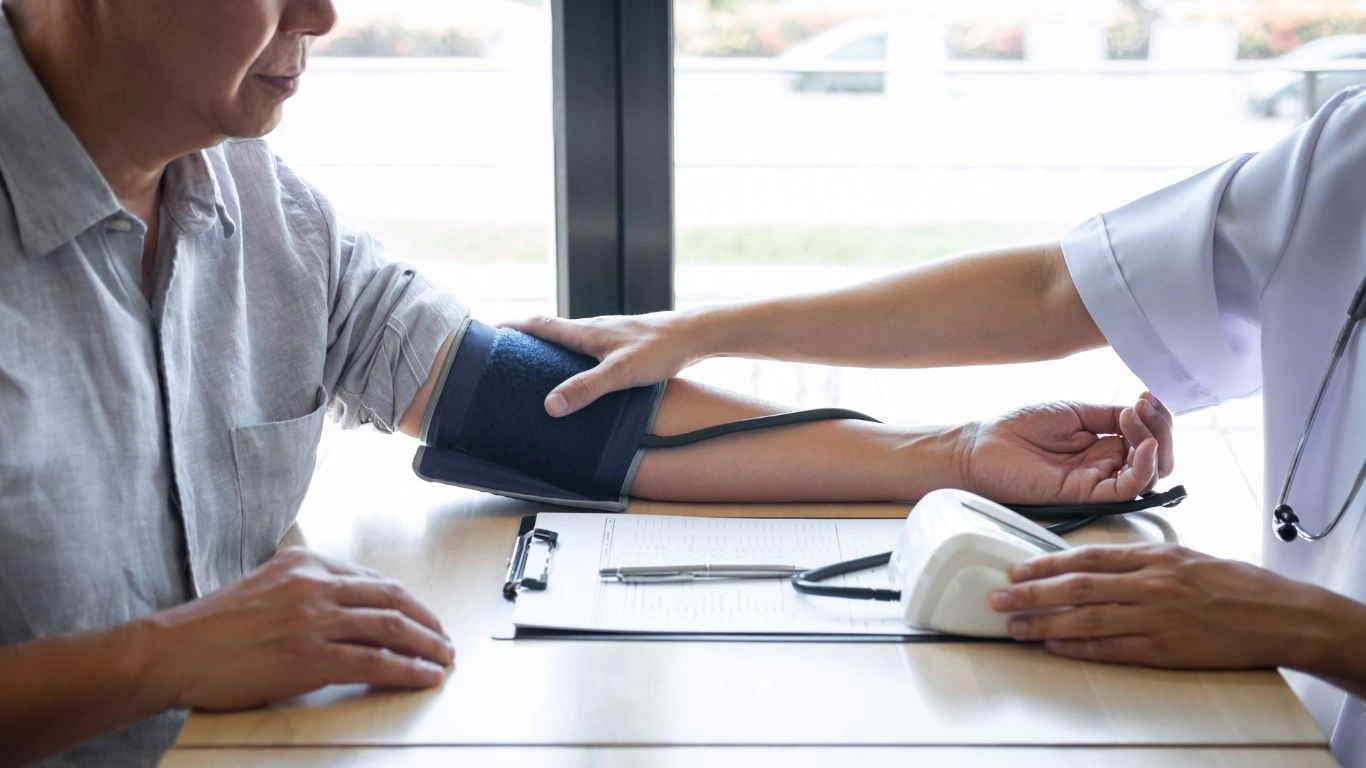How Posture Affects Blood Pressure Readings: The Vital Truth You Must Know
As an internal medicine physician who’s spent years knee-deep in the nuances of hypertension management, I’ve noticed a recurring issue that doesn’t get nearly enough attention — posture. Yep, you heard me. How posture affects blood pressure readings isn’t just a technicality for nurses to fuss over; it can make the difference between a correct diagnosis and a totally misleading one. Trust me, I’ve had patients on the brink of unnecessary medication adjustments, all because their arm wasn’t at heart level or they were slouched in a chair like it was Netflix night. It’s wild how something so simple can create such a ripple effect in someone’s health journey.
Why Posture Isn’t Just a Side Note in Blood Pressure Checks

Let’s get one thing clear: your body isn’t a static machine. It’s reactive, dynamic, and constantly interpreting your position in space. Blood pressure measurements are supposed to reflect your cardiovascular baseline, but if you’re sitting weird or not supported properly, those numbers can be completely off. Think about it — the average patient rolls into a clinic, plops down, and sticks out their arm like they’re waiting for a flu shot. But no one tells them to plant their feet flat on the ground, sit up straight, or rest their arm on a table at heart level. And just like that, the reading we get could be 10, 15, even 20 mmHg higher than their actual baseline.
In clinical practice, I always take a moment to reset. I’ll say something like, “Let’s make sure we’re getting your real numbers, not your stressed-out, ‘just-ran-from-the-parking-lot’ numbers.” It gets a laugh, but it also gives me the opportunity to educate and correct the posture. That moment of adjustment has saved countless patients from being over-treated or misdiagnosed.
Posture and the White Coat Effect
Ah yes, the classic “white coat syndrome.” We’ve all seen it. Patients walk in cool as a cucumber, but as soon as they sit down in front of a clinician, their blood pressure spikes. Now layer that with poor posture, and you’ve got a recipe for numbers that look more like an ER crisis than a routine visit.
From my own experience, when patients are allowed a few minutes to relax in a properly positioned chair with back support, feet flat, and their arm supported, their follow-up readings often come down noticeably. It’s not just about comfort; it’s about accuracy. How posture affects blood pressure readings becomes glaringly obvious when you see a 148/90 drop to 124/78 after a few positioning tweaks and a deep breath or two.
Key Postural Elements That Influence Blood Pressure Readings

- Arm at Heart Level: If the arm is below heart level, readings may be falsely elevated. Above heart level? Readings could be too low.
- Back Supported: Unsupported back means your core is working to hold you up, subtly increasing your blood pressure due to muscular tension.
- Feet Flat on the Floor: Dangling feet or crossed legs can constrict blood flow and skew your numbers.
- No Talking or Movement: Chatting or fidgeting during the reading can cause fluctuations. I always tell my patients, “Think statue — but comfy.”
The Hidden Role of Muscle Tension
One thing that surprised me early in my training — and I still find fascinating — is how minor muscle engagement can affect readings. Clenching your fist, holding your arm up, even sitting at the edge of a chair… these actions all activate sympathetic nervous system responses. I had a patient once whose BP readings were persistently elevated until I realized she was hovering over the edge of the chair, barely resting her back. Once I repositioned her, her systolic dropped 15 points instantly. No meds, just posture.
Small Shifts, Big Impact: Real Patient Stories

I remember a gentleman in his 60s who’d been on three different antihypertensive medications and still had “uncontrolled” readings. During our first visit, I noticed he kept his arm in his lap during the BP measurement. After a few positioning tweaks, guess what? His blood pressure came down to textbook levels. We eventually de-prescribed one of his medications — and he left my office feeling like he got his life back. That’s the power of positioning.
Whether you’re a clinician or someone monitoring your BP at home, understanding how posture affects blood pressure readings is one of the most overlooked but high-impact pieces of the hypertension puzzle. And frankly, it’s one of the easiest to fix.
How Home Monitoring Gets It Wrong (And How to Fix It)

So let’s talk about home blood pressure monitors — those little devices that show up in medicine cabinets, kitchen tables, and sometimes even in glove compartments. They’re useful, don’t get me wrong, but only if folks know how to use them correctly. And spoiler alert: most people don’t.
In my practice, I often ask patients to bring in their home monitor so we can compare readings. Nine times out of ten, they’re either holding the cuff wrong, keeping their legs crossed, or chatting while the monitor inflates. One of my patients even admitted to measuring her BP while on the phone with her daughter and cooking pasta — multitasking queen, but let’s just say her numbers were way off the charts.
Posture Is Just as Important at Home
People tend to think accuracy is only crucial in the doctor’s office. Nope. How posture affects blood pressure readings matters just as much at home — maybe even more, because these readings guide treatment decisions when you’re not in a clinical setting. Whether you’re doing a 7-day BP log or checking before bed, you need a calm body and proper posture to get a true snapshot of your cardiovascular health.
- Sit in a chair with back support.
- Place feet flat on the floor — not on the couch, not tucked under you.
- Rest the arm at heart level on a table or firm surface.
- Don’t talk. Don’t scroll. Just breathe normally and relax.
And here’s the kicker — wait at least five minutes in that position before you even press the button. I usually tell my patients, “Think of it like meditation with a medical purpose.” It helps frame the routine as something intentional, not just another task to check off.
The Role of Body Position Changes: Lying Down vs. Sitting

Another thing we don’t always teach well in clinics: body position changes. Whether you’re sitting, lying down, or standing, your blood pressure can shift dramatically. It’s why we do orthostatic vitals in patients with dizziness or lightheadedness — your body’s pressure regulation is highly positional. But even outside of clinical concerns, body position can mess with routine BP checks.
Let me give you an example. A patient came in once with a home BP log that seemed erratic — one day 132/84, next day 117/70, then 140/90. I asked how she was checking it. Turns out she measured once sitting upright in a chair, once while reclining on her couch, and once after walking her dog. Same device, totally different contexts.
We repeated the readings in my office under controlled posture and rest — all consistent and well-managed. The take-home message? Consistency and positioning matter more than people realize. You can’t compare a lying-down reading to a post-coffee, mid-morning standing one and expect a clear picture.
Quick Tip: Pick One Time and One Setup
If you’re monitoring at home, pick a consistent time (morning is great), a quiet environment, and the same chair/table setup every time. Repetition helps create a reliable trend, which is what we clinicians care most about. One-off spikes aren’t the end of the world; it’s the pattern that tells the real story.
Devices and Cuffs: The Gear Matters Too

Now, let’s get nerdy for a sec — because your gear really does matter. I can’t count how many times I’ve seen patients using a wrist cuff or a worn-out upper arm cuff that’s three sizes too small. It’s like trying to weigh yourself on a wobbly scale. And here’s the kicker — using the wrong cuff size can throw off your reading by as much as 10-15 mmHg. That’s the difference between controlled and uncontrolled hypertension.
Here’s what to check:
- Cuff size: Make sure the bladder of the cuff covers about 80% of your upper arm’s circumference.
- Cuff placement: About 1 inch above the elbow crease, snug but not tight.
- Arm supported: Don’t let the cuffed arm hang or float. It needs full support at heart level.
One patient of mine was logging daily readings that were always high, and she was panicked. When she brought in her device, I saw immediately — she was using a kid-sized cuff from an old machine. We switched it out, and just like that, her readings normalized. It was such a relief for her (and me!).
Trust, But Verify: Bring Your Monitor to the Clinic
If you’re unsure about your setup, bring your home BP monitor to your next visit. As physicians, we can check its accuracy against our calibrated devices. It’s something I always offer my patients, and it builds trust. They walk away feeling confident that their readings mean something — and that they’re not being misled by bad equipment or sloppy posture.
Practical Tips to Get Your Posture—and Blood Pressure Readings—Just Right

Alright, after diving deep into how posture affects blood pressure readings, let’s get practical. From my years in internal medicine, I’ve seen the most stubborn hypertension cases get “fixed” simply by teaching patients to sit right and take their readings mindfully. Here’s a rundown of what I always recommend, the stuff I wish every patient knew before their first BP check:
- Find a comfortable chair with back support: It’s tempting to plop down anywhere, but a chair that supports your back helps keep your muscles relaxed, preventing artificially high readings.
- Feet flat on the floor: No crossing, no dangling. This stabilizes your circulation and keeps your blood flow steady.
- Arm supported at heart level: Prop it up on a table or armrest. If the arm is hanging down or held up, it throws off the measurement.
- Relax for 5 minutes before measuring: Give your body time to settle. No rushing.
- Don’t talk or move: Yes, this means no scrolling on your phone while measuring. I know, easier said than done.
It sounds simple, but trust me—these little details make a huge difference. When patients get the hang of it, their readings become more reliable, which means better treatment decisions. I always remind my patients that measuring blood pressure is almost like a mini self-care ritual, not just a quick number to jot down.
Making Posture Part of Your Daily Routine
One trick I share is to pick a consistent spot in your home for BP checks. That way, you’re more likely to remember all the posture details. Also, integrating deep breathing before measuring helps lower stress and reduce false highs. It’s like telling your nervous system, “Hey, it’s chill time.”
In fact, I had a patient who used to get borderline high readings until she started doing a brief 2-minute breathing exercise while sitting upright before each check. Suddenly, her numbers stabilized, and she felt more in control of her health. This goes beyond posture—it’s about how you prepare your body mentally and physically for the reading.
When Posture Isn’t Enough: What Else Can Affect Blood Pressure Readings?

Of course, posture isn’t the only player in the blood pressure game. Things like caffeine, stress, recent activity, and even full bladders can skew your results. Over the years, I’ve noticed many patients are surprised when I ask them to empty their bladder before checking their BP. It’s one of those subtle but real influences.
Also, environmental factors like room temperature matter. Cold rooms can cause blood vessels to constrict, temporarily raising your pressure. So, if you’re shivering while measuring, your numbers might be falsely elevated.
From personal experience, one of my most memorable “aha” moments was with a patient who kept getting high BP readings only at the end of the day. Turns out, he was measuring right after doing yard work outside on chilly evenings. Once we moved his routine to a calm, warm spot indoors and adjusted for posture, his readings normalized.
Consistency Is King
The takeaway? While how posture affects blood pressure readings is crucial, the bigger picture is consistency. Try to measure your BP at the same time, in the same position, using the same device, and in a similar environment. That’s what helps us clinicians see your real blood pressure trends and avoid unnecessary medication changes.
Expert Insights: What Medical Guidelines Say About Posture and Blood Pressure
Trusted medical organizations echo the importance of posture in blood pressure measurement. The American Heart Association recommends sitting quietly with back supported and feet flat on the floor, and arm supported at heart level. Similarly, the Agency for Healthcare Research and Quality emphasizes standardized measurement techniques for accurate BP readings, including posture control.
These recommendations aren’t just academic—they’re grounded in solid evidence and reinforced by years of clinical experience, like mine. I always make sure my patients understand that these seemingly small details can change their health outcomes significantly.
Wrapping Up This Journey on Posture and Blood Pressure
Before we call it a day, here’s a quick recap: posture matters — a lot. It can make the difference between “high blood pressure” and “just fine.” The good news? With a bit of mindfulness and a few simple tweaks, you can take charge of your readings and make sure they truly reflect your heart health.
If you’re managing hypertension or just want to keep an eye on your cardiovascular wellness, remember the power of posture. And if ever in doubt, bring your monitor along and ask your healthcare provider for a posture check. It’s one of the easiest ways to take control of your health journey.
References
Disclaimer
This article is intended for informational purposes only and does not replace professional medical advice. Always consult your healthcare provider for personalized recommendations regarding blood pressure management and related health concerns.

Dr. Gwenna Aazee is a board-certified Internal Medicine Physician with a special focus on hypertension management, chronic disease prevention, and patient education. With years of experience in both clinical practice and medical writing, she’s passionate about turning evidence-based medicine into accessible, actionable advice. Through her work at Healthusias.com, Dr. Aazee empowers readers to take charge of their health with confidence and clarity. Off the clock, she enjoys deep dives into nutrition research, long walks with her rescue pup, and simplifying medical jargon one article at a time.






